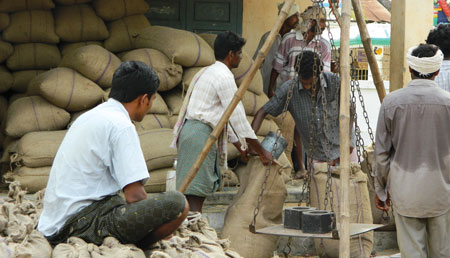 Andhra Pradesh produced 14 million tonnes of rice this year. In absence of storage space many schools function as godowns
Andhra Pradesh produced 14 million tonnes of rice this year. In absence of storage space many schools function as godowns
Photo: M Suchitra
A chanta, a small village in Andhra Pradesh, hit the headlines in 1967 with a record rice yield in the kharif or monsoon crop season. It was the time of the Green Revolution. N Subba Rao, a farmer from the village, harvested three tonnes of paddy from just one kilogramme of seeds. Other farmers followed suit and the village became a model for intensified rice farming.
Achanta is in the spotlight again, this time for declaring a “crop holiday” ahead of the kharif season. Despite a bumper yield of paddy in the rabi or winter crop season this year, 3,500 farmers of the village have decided to stay away from paddy cultivation. “The decision is sad and harsh but we have no choice,” says Subba Rao, now in his seventies. “While the cost of cultivation is rising, we do not even get the minimum support price (MSP) for our grains. Besides, there is no storage space or buyers,” he says ruefully. The International Rice Research Institute felicitated him with the Outstanding Rice Farmer of the World in 1985.
Achanta farmers in East Godavari district harvested some 600,000 bags of paddy (1 bag=75 kg) during the previous kharif. They have managed to sell 60,000 bags so far, that too at a price much below MSP of Rs 1,030 per 100 kg.
Farmers in other villages in West and East Godavari districts, which fall in the fertile Godavari-Krishna delta and are known as the state’s rice bowl, have also declared a crop holiday. The sentiment is fast spreading across the state.
Analysts say this is perhaps the first time in the country that paddy farmers have resorted to such a drastic step, that too in a Green Revolution belt. Andhra Pradesh on an average produces 13 million tonnes of rice a year and is the second largest rice grower in the country after West Bengal (14.8 million tonnes). It contributes 9 million tonnes of rice to the Central pool through the Food Corporation of India (FCI).
Plenty became problem
Farmers say the main reason for the unrest is they are not able to sell the bumper rabi harvest, which they grew despite heavy losses during the previous kharif season. Excessive and untimely rain had destroyed kharif crop in large tracts of the state last year. Small tenant farmers are the worst-hit. Since they are not eligible for government compensation for crop loss or bank credits, they grew the rabi crop with high-interest loans from moneylenders. “We reaped a good harvest but are not able to earn from it,” says G Ramachandra Rao of Sannavalli in East Godavari. The only way to reduce the loss is to not grow paddy this kharif, says Satti Lankanna, another farmer.